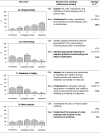Statistical competencies for medical research learners: What is fundamental?
- PMID: 29082029
- PMCID: PMC5647667
- DOI: 10.1017/cts.2016.31
Statistical competencies for medical research learners: What is fundamental?
Abstract
Introduction: It is increasingly essential for medical researchers to be literate in statistics, but the requisite degree of literacy is not the same for every statistical competency in translational research. Statistical competency can range from 'fundamental' (necessary for all) to 'specialized' (necessary for only some). In this study, we determine the degree to which each competency is fundamental or specialized.
Methods: We surveyed members of 4 professional organizations, targeting doctorally trained biostatisticians and epidemiologists who taught statistics to medical research learners in the past 5 years. Respondents rated 24 educational competencies on a 5-point Likert scale anchored by 'fundamental' and 'specialized.'
Results: There were 112 responses. Nineteen of 24 competencies were fundamental. The competencies considered most fundamental were assessing sources of bias and variation (95%), recognizing one's own limits with regard to statistics (93%), identifying the strengths, and limitations of study designs (93%). The least endorsed items were meta-analysis (34%) and stopping rules (18%).
Conclusion: We have identified the statistical competencies needed by all medical researchers. These competencies should be considered when designing statistical curricula for medical researchers and should inform which topics are taught in graduate programs and evidence-based medicine courses where learners need to read and understand the medical research literature.
Keywords: Clinical and Translational Science; Evidence-Based Medicine; Public Health; Statistical competency; team science.
Figures


References
-
- Oxford Dictionary [Internet]. http://www.oxforddictionaries.com/us/definition/american_english/competence. Last accessed April 12, 2017.
-
- CTSA Education Core Competency Workgroup. Core Competencies in Clinical and Translational Science for Master’s Candidates, Revised 2011 [Internet]. [cited May 25, 2016]. (https://ctsacentral.org/wp-content/documents/CTSA%20Core%20Competencies_...)
Grants and funding
- UL1 TR000433/TR/NCATS NIH HHS/United States
- UL1 TR000150/TR/NCATS NIH HHS/United States
- UL1 TR002001/TR/NCATS NIH HHS/United States
- UL1 TR000042/TR/NCATS NIH HHS/United States
- UL1 TR001108/TR/NCATS NIH HHS/United States
- UL1 TR001425/TR/NCATS NIH HHS/United States
- UL1 TR001417/TR/NCATS NIH HHS/United States
- UL1 TR000371/TR/NCATS NIH HHS/United States
- UL1 TR001433/TR/NCATS NIH HHS/United States
- UL1 TR000001/TR/NCATS NIH HHS/United States
- TL1 TR000096/TR/NCATS NIH HHS/United States
- UL1 TR000135/TR/NCATS NIH HHS/United States
- UL1 TR000002/TR/NCATS NIH HHS/United States
- UL1 TR002240/TR/NCATS NIH HHS/United States
- UL1 TR001117/TR/NCATS NIH HHS/United States
- UL1 TR001439/TR/NCATS NIH HHS/United States
LinkOut - more resources
Full Text Sources
Other Literature Sources
Miscellaneous
